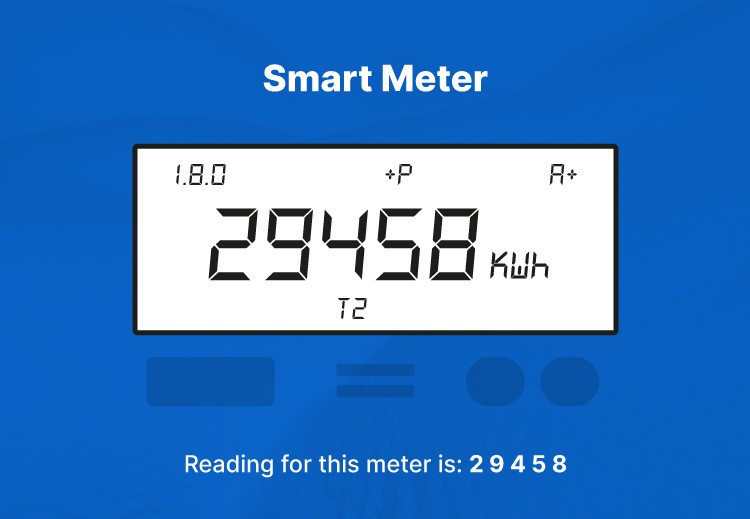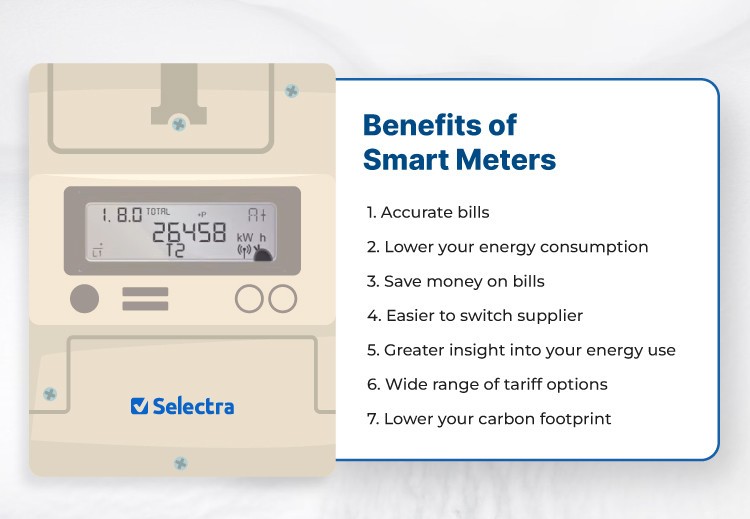What Is an ESB Smart Meter in Ireland?

Smart meters in Ireland work by transmitting real-time information to your electricity provider, ensuring that you get accurate and detailed billing for your energy consumption. There are three different rates for customers using a smart meter, a day rate, a higher peak rate and a lower night rate. The incentive is to change your electricity consuming habits in order to take advantage of the cheaper night rate and thereby reduce your electricity bills.
What Is a Smart Meter?
Smart meters in Ireland are digital devices that track your electricity use and send data to your supplier.
They provide accurate billing, help you understand your consumption, and allow you to take advantage of cheaper off-peak rates.
Simply put, a smart meter is a type of electricity meter is a device that counts your electricity usage in real-time and wirelessly relays that information to your energy provider.
This allows you to have up-to-the-minute control over your electricity consumption, intended to help reduce electricity usage in your home.
Having a smart meter eliminates the need to submit meter readings, which means that you shouldn't be overcharged on your energy bills that can sometimes happen when your usage is estimated.
Your smart meter transmits your electricity usage wirelessly via a secure 2G mobile phone network, provided by Three Ireland Limited.
The technology used in the ESB smart meter to supplier communications employs multiple layers of cybersecurity and complies with all applicable data privacy and protection laws.
What are Smart Tariffs and Time-Of-Use Tariffs?
Unlike standard electricity tariffs, smart meter tariffs offer different prices for electricity throughout the day. These are known as Time-of-Use tariffs.
These tariffs are designed to encourage consumers to avoid using electricity at peak times and shift their usage to cheaper nightime rates.
There are various types of smart tariffs available to homeowners;
- Standard Smart Tariff
- Weekend Smart Tariff
- 24 hour Smart Tariff
All suppliers are required to offer a Standard Smart Plan with three unit rates:
| Unit Rate | Time | Price |
|---|---|---|
| Day | 08:00 - 17:00 | €€ |
| Peak | 17:00 - 19:00 | €€€ |
| Night | 19:00 - 23:00 | €€ |
| EV | 23:00 - 08:00 | € |
Special smart meter tariffs are also available for electric vehicle owners that offer an extra-low, nighttime rate for charging your electric vehicle.
Some suppliers also offer free weekend electricity as part of their smart tariffs.
⚡ Top Smart Meter Tariffs
| Supplier | Estimated Annual Bill | Details | Score |
|---|---|---|---|
 Smart Electricity |
1374.43 € Call to Compare Prices |
|
 |
 Smart Electricity |
1439.26 € Call to Compare Prices |
|
 |
 Smart Electricity |
1463.94 € Call to Compare Prices |
|
 |
 Smart Electricity |
1476.48 € Call to Compare Prices |
|
 |
 Smart Electricity |
1543.28 € Call to Compare Prices |
|
 |
 Smart Electricity |
1597.23 € Call to Compare Prices |
|
 |
 Smart Electricity |
1610.98 € Call to Compare Prices |
|
 |
 Smart Electricity |
1646.47 € Call to Compare Prices |
|
 |
 Smart Electricity |
1830.27 € Call to Compare Prices |
|
 |
*Figures are for illustrative purposes only. Calculations based on average consumption figures for an urban home with a standard meter. All new customer discounts have been applied.
Read more about the Selectra Score.
What Is The Best Smart Meter Plan in Ireland?
How Do I Shift My Usage With A Smart Meter?
To truly unlock the savings potential of a smart meter, you must consciously shift your consumption patterns to align with the cheaper unit rates. The three core time bands for the Standard Smart Tariff (SST) in Ireland are:
| Rate (ESB Networks T-Code) | Time Period | Price Tier | Savings Action |
|---|---|---|---|
| T2 (Peak) | 17:00 – 19:00 | Highest (€€€) | AVOID: Do not run high-draw appliances (dishwasher, washing machine, dryer, immersion heater) during these two evening hours. |
| T1 (Day) | 08:00 – 17:00 & 19:00 – 23:00 | Mid-Tier (€€) | MODERATE USE: Normal daytime activities. Run washing cycles before 5 PM or after 7 PM. |
| T3 (Night) | 23:00 – 08:00 | Lowest (€) | TARGET: Run all non-essential high-draw appliances during this period. The greater your usage here, the higher your savings. |
Practical Steps to Maximize Savings
- Delay Dishwashers & Laundry: Use timers to schedule washing machines, tumble dryers, and dishwashers to start after 11:00 PM or early in the morning before 8:00 AM.
- Off-Peak Heating: If you have an immersion heater, use a timer plug to heat water during the T3 night-time rate.
- EV Charging: If you own an Electric Vehicle (EV), look for a dedicated EV Smart Tariff. These often provide an extra-low rate during the deepest off-peak hours (e.g., 2:00 AM – 5:00 AM), which should always be prioritized for charging.
- Batch Cooking: Minimize the use of the oven or hob during the short but expensive 5 PM – 7 PM peak window. Prepare meals earlier in the day or use slower cooking methods during the night-time rate.
- Monitor Daily: Use the ESB Networks Online Account or your supplier's app to check your usage. Seeing the cost breakdown for T1, T2, and T3 will reinforce good habits.
Is There an ESB Smart Meter App?
Unfortunately, there is not an official ESB Networks smart meter app, but you can create access the data from your smart meter through the ESB Networks Online Account.
Through your account, you can view details of your electricity usage to help you understand and manage your consumption.
To sign up, all you need to do is visit the ESB Networks Account registration page and submit the following details:
- Email address
- MPRN number
- Mobile number
Once signed up, you will be able to access your smart meter information including:
- Charts showing your electricity usage over a week, which you can also switch between daily, monthly, or yearly views through the drop-down menu above the chart.
- Breakdown of your electricity usage during the day/ night/ peak periods.
- The data is updated regularly, but it could take 36–48 hours for data to appear on your online account.
How Do You Read an ESB Smart Meter?
Every smart meter has a digital screen from which you can select the display option of your choice. Simply push the large black button on the left-hand side and scroll between display options.
Your cumulative meter reading should be the number displayed in the centre of the digital screen.

Here is the information found from the default display:
- Shows the cumulative kWh usage for a 24-hour period
- Current Time-Of-Use tariff (i.e. T1, T2, T3) for day, night, or peak tariff
- Meter signal strength
- Voltage and the direction of feed (import or export for those selling back energy produced from their solar panels, windmill, or another source).
Do not confuse smart meters with electricity monitors, or In-Home Display (IHD) monitors. Currently, we know of two electricity suppliers, Electric Ireland and Pinergy, who provide IHDs with their smart meter plans.
By looking at an electricity monitor, you'll be able to see how much energy you are consuming and how much you are spending, in near real-time.
Roughly the size of a smartphone, you can place the device anywhere you like in your house.
What Are the Pros and Cons of a Smart Meter?
If you're looking for ways to save money on your electricity bills, a smart meter can help by allowing you to monitor and cut back on your consumption.
Smart meters in Ireland will also give you access to a wider variety of tariffs, some of which offer cheaper prices during certain hours.

Smart Meter Advantages in Ireland
Let's have a look at some of the various advantages of ESB smart meters.
- Accurate Billing
Smart meters automatically send accurate meter readings to your energy supplier, you no longer need to deal with estimated bills. - Real-Time Display
With a smart meter, customers can use the In-Home Display monitor, their online account, or an app to see how much energy they are consuming. - Savings
Studies suggest that customers with a smart meter could save an additional 2.5% on their average electricity bills per year (around €30) because of increased awareness of their consumption. - Eliminate Inefficient Devices
A smart meter allows you to identify which appliances are consuming the most energy. You can then easily take steps to replace items or encourage energy-saving behaviour. - Curb Your Behaviour
There are many ways to reduce your bills by changing energy spending habits in your household. A smart meter can help you easily identify these. - Access Better Tariffs
An ESB smart meter allows for time-of-use tariffs. These tariffs take consumption patterns into account and allow consumers to take advantage of cheaper rates during off-peak hours. With this type of tariff, you could save up to 8% (around €80 a year) on your energy bills if you consume more than a quarter of your energy during off-peak times. - Reduce Carbon Footprint
Smart meters will aid Ireland’s Climate Action Plan. Less energy consumption equals less demand. Less demand means a further reduction in carbon-producing fuels that produce electricity. - Support Renewable Energy
Smart meters will be able to calculate electricity imports and exports. This means that customers who have additional energy sources, such as solar power, wind farms, will find it easier to feed their excess electricity back into the grid and get paid for it.
Are There Any Disadvantages to Smart Meters in Ireland?
Let's examine some of the various disadvantages of ESB smart meters.
- Cost
Advertised as a ‘Free’ installation, the ESB smart meter rollout will incur an additional network charge for all customers, no matter if you have a smart meter or not. This will be the nominal amount of €5.50 a year added to your bill for the next 20 years. - No Turning Back
Once you decide to have a smart meter installed, there is not a change of mind policy. You cannot return to your old-style meter if you are not happy with these new, modern ones. - Not Fail-Proof
Some smart meter customers in the UK have also reported issues with faulty meters, contributing to an increase in their bills. - Dependent on Phone Signal
If you live in a remote area where the phone signal is low, your smart meter will not work efficiently. - Overestimated Savings
An overestimate of the potential savings given smart meter plans are advertised using the average annual consumption.
All Your Smart Meter Questions Answered!
Are Smart Meters Compulsory in Ireland?
While the ESB program for smart meter installation aims to equip all homes and businesses with smart meters, consumers are not legally obligated to participate and can opt out by contacting ESB Networks directly.
However, it's important to consider that future energy systems may increasingly rely on smart meter technology, potentially limiting options for those who choose to retain traditional meters.
To date, ESB Networks have already installed over 1.9 million smart meters in Irish homes and businesses.
To get an ESB smart meter installed, contact the distributor directly or your energy supplier. You can reach ESB Networks on 1800 928 123 or 01 698 5005.
ESB does the smart meter installation for free and will contact you before carrying out the work.
Who Installs Your Smart Meter?
The rollout is part of the National Smart Metering Programme managed by ESB Networks—not your energy supplier. ESB Networks will contact you directly when installation is scheduled for your area.
- Notification: You will receive a letter from ESB Networks providing an estimated date for the meter exchange.
- Booking: You may be asked to contact them to confirm the date or book a specific time if your meter is located inside your home or business.
- Cost: The installation itself is carried out for free. However, as noted in the Disadvantages section, a minor network charge to fund the program is applied to all customers' bills over 20 years, regardless of whether you accept the installation.
What Happens on Installation Day?
The process is quick and non-disruptive, typically taking around 45 minutes to one hour.
- Safety First: The ESB Networks technician will isolate the power supply to your meter. Your electricity will be briefly turned off (a short power outage).
- Exchange: The old meter is physically removed, and the new digital smart meter is fitted into the existing casing.
- Power On & Check: The technician restores the power and performs several checks to ensure the new meter is working correctly and communicating with the network.
- Connectivity Activation: Once installed, your meter will begin connecting to ESB Networks' secure communications network. This process can take up to 30 days before the meter is fully 'smart-enabled' and you can sign up for a Time-of-Use tariff.
Crucially, you must have a smart meter installed for at least 30 days before your supplier can enroll you on a smart tariff.
Smart Meters Ireland FAQs
Are ESB Smart Meters Safe?
Yes. ESB Networks and the Commission for Regulation of Utilities (CRU) affirm that smart meters are safe and comply with all necessary national and international health and safety standards.
- Low Emissions: Smart meters use a low-power radio frequency (RF) to communicate, similar to a mobile phone. However, they only transmit data for a few seconds every four to six hours.
- International Standards: Health authorities globally, including the World Health Organization (WHO), have assessed the scientific evidence and confirm that there are no established health effects from smart meters. Emissions are well below the maximum exposure levels set by international guidelines.
Is My Data Secure?
Yes. Data protection and privacy are heavily regulated under GDPR and overseen by the Data Protection Commission (DPC).
- Usage Data: The meter collects data on your consumption every 30 minutes. This granular data is only sent to your chosen energy supplier if you actively opt-in to a smart tariff or smart service.
- Anonymity: If you remain on a standard tariff, ESB Networks only collects and stores the total daily usage figures, which are far less detailed and cannot be used to profile your behaviour in the same way.
- Security: Data transmission is secured using multiple layers of robust cybersecurity to protect your personal consumption patterns.
Read More Of Our Electricity Articles:
What is a GPRN number and how to find it.
Where can I find my MPRN number?
Is PAYG electricity more expensive?
How is the cheapest night rate electricity provider?
